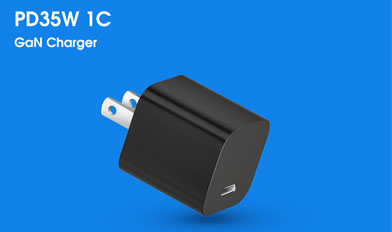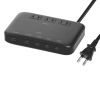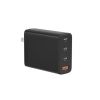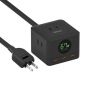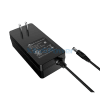What is PD fast charging? How does it work?
Views: 453
Publish Time: 2024-02-07
You may not realize it, but if you’re using a modern smartphone like Huawei, Samsung, you probably know that they already support some form of fast charging.If you're not yet familiar with this technology, let's explain what it is, how it works, and which smartphone manufacturers use which standard?
PD (Power Delivery) fast charging is an advanced charging technology for smartphones and other electronic devices. It uses a flexible charging standard that allows devices to charge at higher powers, resulting in faster charging speeds. The following is a more detailed explanation of PD fast charging and supplementary information:
In PD fast charging, the device communicates with the charger through the USB-C port to exchange the voltage and current it requires. The charger can provide optimal power output based on the needs of the device for faster charging. This intelligent adjustment mechanism makes PD fast charging suitable for a variety of devices, including smartphones, tablets, and laptops.
Compared with other fast charging standards, an important advantage of PD fast charging is its wide compatibility. Many devices from different manufacturers adopt USB-C interfaces and support the PD standard, which means that the same PD charger can be used for multiple brands and models of devices, providing greater flexibility and convenience.
Huawei SuperCharge: Huawei’s super fast charging technology uses an intelligent adjustment mechanism similar to PD fast charging, but has some customized optimizations. It supports higher power output, can charge large-capacity batteries in a short time, and has certain adaptability to adjust the power output according to the status of the device.
Application of PD fast charging in mobile power supplies: In addition to smartphones and devices, PD fast charging technology is also widely used in mobile power supplies. Anker PowerIQ and some other brands of mobile power supplies adopt the PD fast charging standard to provide users with faster and more convenient mobile charging solutions.
Evolution of charging standards: With the continuous development of technology, charging standards are constantly upgraded. The USB PD 3.0 standard introduces higher power output and a more complex negotiation mechanism, further improving charging efficiency and speed.
Samsung's adaptive fast charging technology has been a long-term player in this project. Originally launched on the Samsung Galaxy Note4 in 2014, its output power was 5V and 2A (10W). this is one.A slower fast charging solution.The 3500mAh battery built into the 2018 Samsung Galaxy s9 p1us charged over 40% in 30 minutes and completed a full charge in around 1 hour and 35 minutes using adaptive fast charging
If you want to talk about adaptability, the Anker PowerIQ Standard is worth looking at. The company has already established itself by making oversized portable power banks for smartphones and other personal electronics, but now it's spending more time figuring out how to charge those devices.
PowerIQ is designed to automatically detect and scale the voltage output of one of the company's supported power supplies, such as the PowerCore II line, to provide the optimal charging rate for the device of your choice. It's helped by the company's VoltageBoost technology, which ensures stable power no matter what cable you use.
The latest version of the standard, PowerIQ 2.0 can deliver up to 18W of power. Anker cites a compatible battery pack for the Samsung Galaxy S8 (which has a 3,000mAh battery) achieving a total charge time of 1 hour and 30 minutes.
One of the biggest selling points of the OneP1us3 is the introduction of the company's Dash charging technology; in terms of speed and implementation, this new standard still beats almost every smartphone-centric fast charging standard on the market.
One fundamental difference between Dash Charge and its competitors is that heat build-up occurs almost exclusively in the power adapter itself. Typically, fast charging causes your phone's battery or charge controller and surrounding components to heat up, but 0nePlus' solution will keep your phone completely cool, even when you're using it while charging.
After a bit of a stir, 0neP1us recently rebranded Dash Charging as something more versatile that sounds faster, but the technology behind it is just as powerful. With outputs of 5v and 4A (equivalent to 20w), 0neP1us’ fast-charging technology can charge up to 60% of the 0neP1us 6’s 3300mh battery in just 30 minutes, earning the brand the title “Provides a day’s worth of power in half an hour” "
If you've heard of any form of fast charging technology, it's likely to be chipmaker Qualcomm's fast charging standard. There's a good chance you own a smartphone powered by a Qualcomm processor, which means it supports some level of fast charging - although some phones like the Samsung Galaxy 6 can support fast charging without relying on a Qualcomm processor. As long as they are equipped with a fast charging compliant charge controller. As a flexible and intelligent charging technology, PD fast charging has been widely used in modern electronic devices, providing users with a more convenient and faster charging experience. With the continuous development of technology and the continuous upgrading of charging standards, users can enjoy a more advanced and efficient charging experience.
PD (Power Delivery) fast charging is an advanced charging technology for smartphones and other electronic devices. It uses a flexible charging standard that allows devices to charge at higher powers, resulting in faster charging speeds. The following is a more detailed explanation of PD fast charging and supplementary information:
How does PD fast charging work?
The core of PD fast charging is based on the USB Power Delivery standard, which allows devices to communicate and charge at higher voltage and current through USB-C ports. Compared with traditional charging standards, PD fast charging has greater flexibility and supports different voltage and current combinations to adapt to the needs of different devices.In PD fast charging, the device communicates with the charger through the USB-C port to exchange the voltage and current it requires. The charger can provide optimal power output based on the needs of the device for faster charging. This intelligent adjustment mechanism makes PD fast charging suitable for a variety of devices, including smartphones, tablets, and laptops.
Compared with other fast charging standards, an important advantage of PD fast charging is its wide compatibility. Many devices from different manufacturers adopt USB-C interfaces and support the PD standard, which means that the same PD charger can be used for multiple brands and models of devices, providing greater flexibility and convenience.
What are the advanced fast charges on the market?
Huawei SuperCharge: Huawei’s super fast charging technology uses an intelligent adjustment mechanism similar to PD fast charging, but has some customized optimizations. It supports higher power output, can charge large-capacity batteries in a short time, and has certain adaptability to adjust the power output according to the status of the device.
Application of PD fast charging in mobile power supplies: In addition to smartphones and devices, PD fast charging technology is also widely used in mobile power supplies. Anker PowerIQ and some other brands of mobile power supplies adopt the PD fast charging standard to provide users with faster and more convenient mobile charging solutions.
Evolution of charging standards: With the continuous development of technology, charging standards are constantly upgraded. The USB PD 3.0 standard introduces higher power output and a more complex negotiation mechanism, further improving charging efficiency and speed.
Fast charging application cases in mobile phone field
Samsung's adaptive fast charging technology has been a long-term player in this project. Originally launched on the Samsung Galaxy Note4 in 2014, its output power was 5V and 2A (10W). this is one.A slower fast charging solution.The 3500mAh battery built into the 2018 Samsung Galaxy s9 p1us charged over 40% in 30 minutes and completed a full charge in around 1 hour and 35 minutes using adaptive fast charging
If you want to talk about adaptability, the Anker PowerIQ Standard is worth looking at. The company has already established itself by making oversized portable power banks for smartphones and other personal electronics, but now it's spending more time figuring out how to charge those devices.
PowerIQ is designed to automatically detect and scale the voltage output of one of the company's supported power supplies, such as the PowerCore II line, to provide the optimal charging rate for the device of your choice. It's helped by the company's VoltageBoost technology, which ensures stable power no matter what cable you use.
The latest version of the standard, PowerIQ 2.0 can deliver up to 18W of power. Anker cites a compatible battery pack for the Samsung Galaxy S8 (which has a 3,000mAh battery) achieving a total charge time of 1 hour and 30 minutes.
One of the biggest selling points of the OneP1us3 is the introduction of the company's Dash charging technology; in terms of speed and implementation, this new standard still beats almost every smartphone-centric fast charging standard on the market.
One fundamental difference between Dash Charge and its competitors is that heat build-up occurs almost exclusively in the power adapter itself. Typically, fast charging causes your phone's battery or charge controller and surrounding components to heat up, but 0nePlus' solution will keep your phone completely cool, even when you're using it while charging.
After a bit of a stir, 0neP1us recently rebranded Dash Charging as something more versatile that sounds faster, but the technology behind it is just as powerful. With outputs of 5v and 4A (equivalent to 20w), 0neP1us’ fast-charging technology can charge up to 60% of the 0neP1us 6’s 3300mh battery in just 30 minutes, earning the brand the title “Provides a day’s worth of power in half an hour” "
If you've heard of any form of fast charging technology, it's likely to be chipmaker Qualcomm's fast charging standard. There's a good chance you own a smartphone powered by a Qualcomm processor, which means it supports some level of fast charging - although some phones like the Samsung Galaxy 6 can support fast charging without relying on a Qualcomm processor. As long as they are equipped with a fast charging compliant charge controller. As a flexible and intelligent charging technology, PD fast charging has been widely used in modern electronic devices, providing users with a more convenient and faster charging experience. With the continuous development of technology and the continuous upgrading of charging standards, users can enjoy a more advanced and efficient charging experience.
×
×
Inquire
By continuing to use the site you agree to our privacy policy Terms and Conditions.
I agree

